VOLVO V90 CROSS COUNTRY 2017 Owner´s Manual
Manufacturer: VOLVO, Model Year: 2017, Model line: V90 CROSS COUNTRY, Model: VOLVO V90 CROSS COUNTRY 2017Pages: 552, PDF Size: 13.6 MB
Page 211 of 552
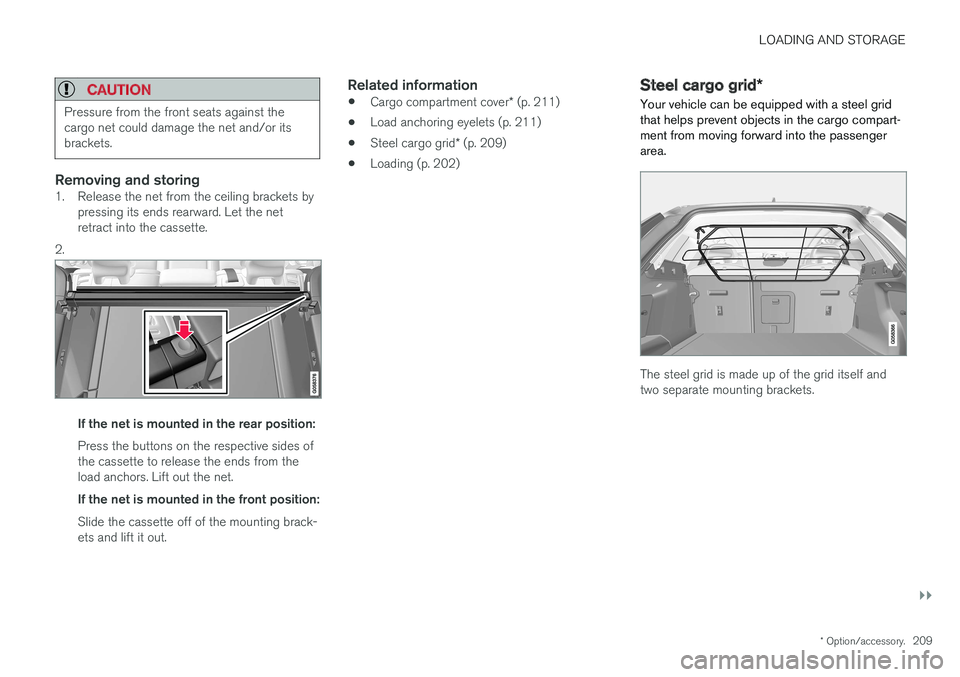
LOADING AND STORAGE
}}
* Option/accessory.209
CAUTION
Pressure from the front seats against the cargo net could damage the net and/or itsbrackets.
Removing and storing1. Release the net from the ceiling brackets by
pressing its ends rearward. Let the net retract into the cassette.
2.
If the net is mounted in the rear position: Press the buttons on the respective sides of the cassette to release the ends from theload anchors. Lift out the net. If the net is mounted in the front position: Slide the cassette off of the mounting brack- ets and lift it out.
Related information
• Cargo compartment cover
* (p. 211)
• Load anchoring eyelets (p. 211)
• Steel cargo grid
* (p. 209)
• Loading (p. 202)
Steel cargo grid
*
Your vehicle can be equipped with a steel grid that helps prevent objects in the cargo compart-ment from moving forward into the passengerarea.
The steel grid is made up of the grid itself and two separate mounting brackets.
Page 212 of 552
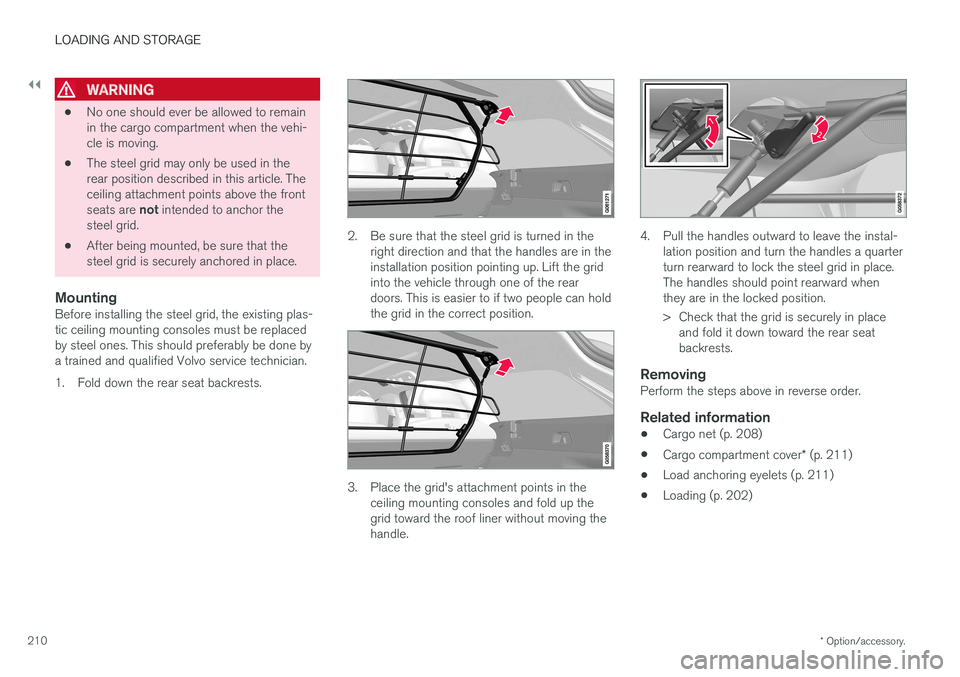
||
LOADING AND STORAGE
* Option/accessory.
210
WARNING
• No one should ever be allowed to remain in the cargo compartment when the vehi-cle is moving.
• The steel grid may only be used in therear position described in this article. Theceiling attachment points above the front seats are
not intended to anchor the
steel grid.
• After being mounted, be sure that the steel grid is securely anchored in place.
MountingBefore installing the steel grid, the existing plas-tic ceiling mounting consoles must be replacedby steel ones. This should preferably be done bya trained and qualified Volvo service technician.
1. Fold down the rear seat backrests.
2. Be sure that the steel grid is turned in the
right direction and that the handles are in the installation position pointing up. Lift the gridinto the vehicle through one of the reardoors. This is easier to if two people can holdthe grid in the correct position.
3. Place the grid's attachment points in theceiling mounting consoles and fold up the grid toward the roof liner without moving thehandle.
4. Pull the handles outward to leave the instal- lation position and turn the handles a quarter turn rearward to lock the steel grid in place.The handles should point rearward whenthey are in the locked position.
> Check that the grid is securely in placeand fold it down toward the rear seat backrests.
RemovingPerform the steps above in reverse order.
Related information
• Cargo net (p. 208)
• Cargo compartment cover
* (p. 211)
• Load anchoring eyelets (p. 211)
• Loading (p. 202)
Page 213 of 552
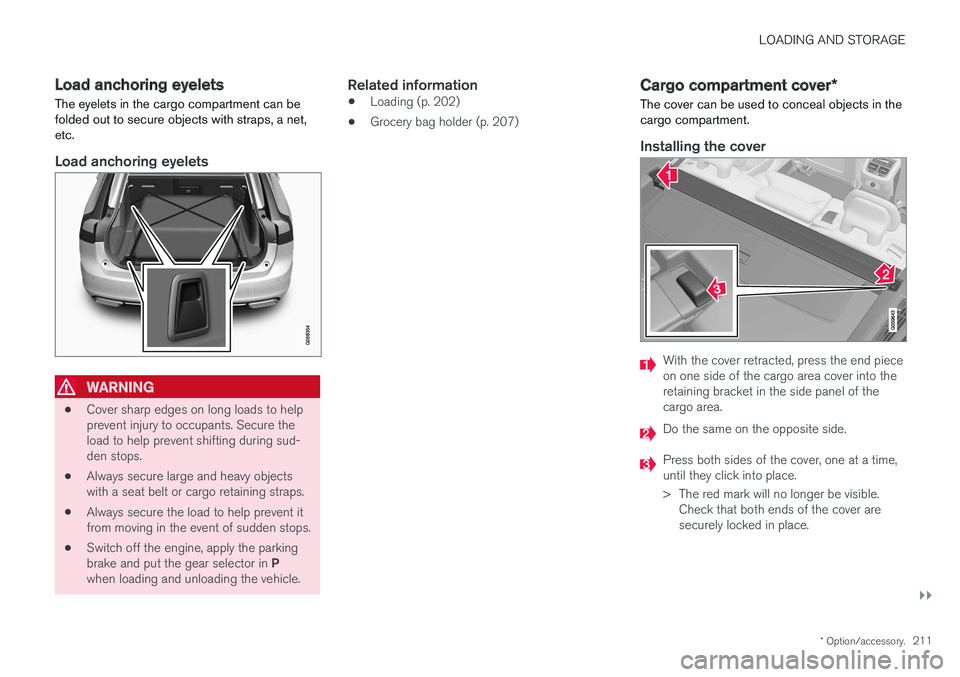
LOADING AND STORAGE
}}
* Option/accessory.211
Load anchoring eyelets
The eyelets in the cargo compartment can be folded out to secure objects with straps, a net,etc.
Load anchoring eyelets
WARNING
• Cover sharp edges on long loads to help prevent injury to occupants. Secure theload to help prevent shifting during sud-den stops.
• Always secure large and heavy objectswith a seat belt or cargo retaining straps.
• Always secure the load to help prevent itfrom moving in the event of sudden stops.
• Switch off the engine, apply the parking brake and put the gear selector in
P
when loading and unloading the vehicle.
Related information
• Loading (p. 202)
• Grocery bag holder (p. 207)
Cargo compartment cover
*
The cover can be used to conceal objects in the cargo compartment.
Installing the cover
With the cover retracted, press the end piece on one side of the cargo area cover into theretaining bracket in the side panel of thecargo area.
Do the same on the opposite side.
Press both sides of the cover, one at a time, until they click into place.
> The red mark will no longer be visible. Check that both ends of the cover are securely locked in place.
Page 214 of 552
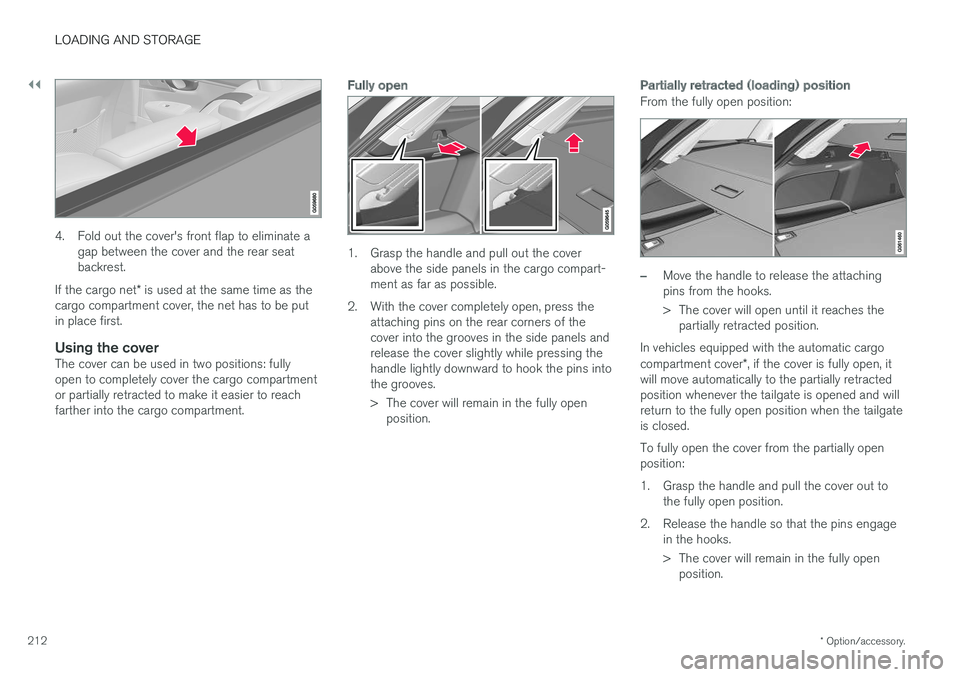
||
LOADING AND STORAGE
* Option/accessory.
212
4. Fold out the cover's front flap to eliminate a
gap between the cover and the rear seat backrest.
If the cargo net * is used at the same time as the
cargo compartment cover, the net has to be putin place first.
Using the coverThe cover can be used in two positions: fullyopen to completely cover the cargo compartmentor partially retracted to make it easier to reachfarther into the cargo compartment.
Fully open
1. Grasp the handle and pull out the cover above the side panels in the cargo compart- ment as far as possible.
2. With the cover completely open, press the attaching pins on the rear corners of thecover into the grooves in the side panels andrelease the cover slightly while pressing thehandle lightly downward to hook the pins intothe grooves.
> The cover will remain in the fully openposition.
Partially retracted (loading) position
From the fully open position:
–Move the handle to release the attaching pins from the hooks.
> The cover will open until it reaches thepartially retracted position.
In vehicles equipped with the automatic cargo compartment cover *, if the cover is fully open, it
will move automatically to the partially retracted position whenever the tailgate is opened and willreturn to the fully open position when the tailgateis closed. To fully open the cover from the partially open position:
1. Grasp the handle and pull the cover out to the fully open position.
2. Release the handle so that the pins engage in the hooks.
> The cover will remain in the fully openposition.
Page 215 of 552
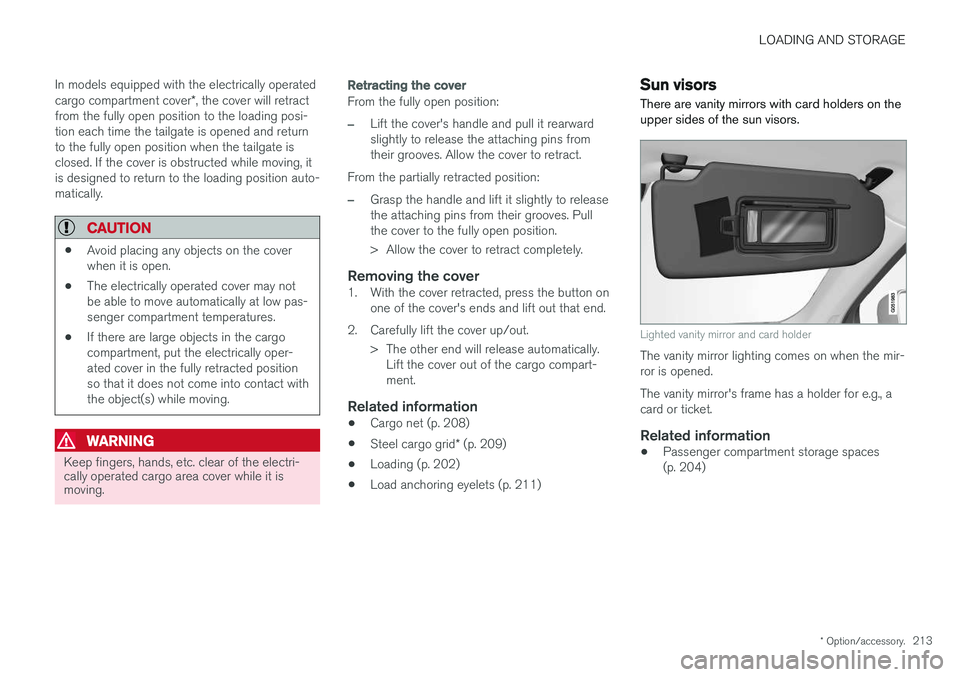
LOADING AND STORAGE
* Option/accessory.213
In models equipped with the electrically operated cargo compartment cover
*, the cover will retract
from the fully open position to the loading posi- tion each time the tailgate is opened and returnto the fully open position when the tailgate isclosed. If the cover is obstructed while moving, itis designed to return to the loading position auto-matically.
CAUTION
• Avoid placing any objects on the cover when it is open.
• The electrically operated cover may notbe able to move automatically at low pas-senger compartment temperatures.
• If there are large objects in the cargocompartment, put the electrically oper-ated cover in the fully retracted positionso that it does not come into contact withthe object(s) while moving.
WARNING
Keep fingers, hands, etc. clear of the electri- cally operated cargo area cover while it ismoving.
Retracting the cover
From the fully open position:
–Lift the cover's handle and pull it rearward slightly to release the attaching pins fromtheir grooves. Allow the cover to retract.
From the partially retracted position:
–Grasp the handle and lift it slightly to release the attaching pins from their grooves. Pullthe cover to the fully open position.
> Allow the cover to retract completely.
Removing the cover1. With the cover retracted, press the button on one of the cover's ends and lift out that end.
2. Carefully lift the cover up/out. > The other end will release automatically.Lift the cover out of the cargo compart- ment.
Related information
• Cargo net (p. 208)
• Steel cargo grid
* (p. 209)
• Loading (p. 202)
• Load anchoring eyelets (p. 211)
Sun visors There are vanity mirrors with card holders on the upper sides of the sun visors.
Lighted vanity mirror and card holder
The vanity mirror lighting comes on when the mir- ror is opened. The vanity mirror's frame has a holder for e.g., a card or ticket.
Related information
•
Passenger compartment storage spaces(p. 204)
Page 216 of 552
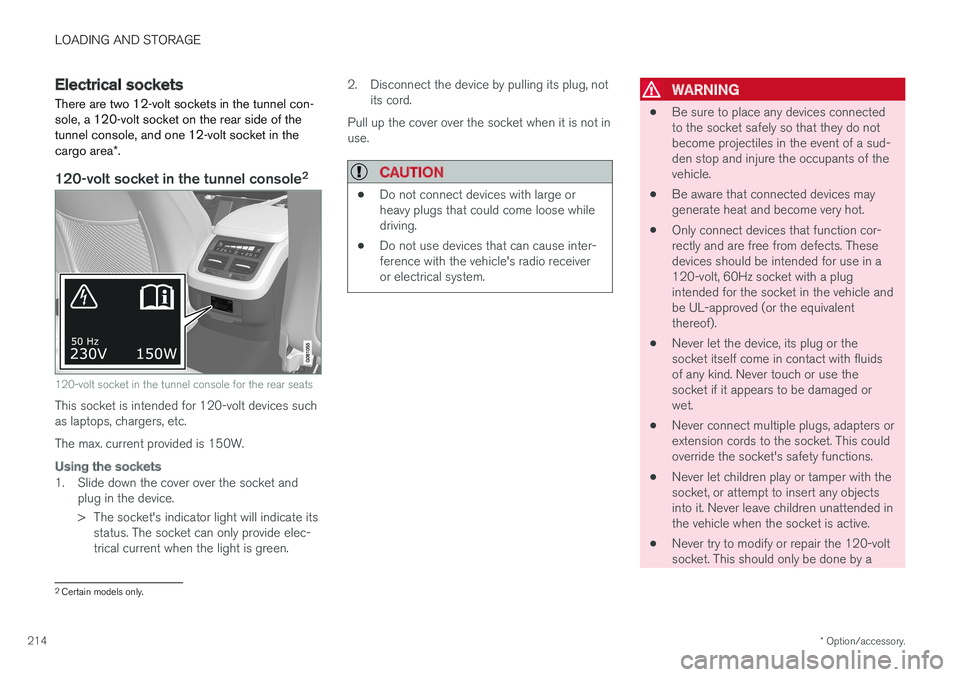
LOADING AND STORAGE
* Option/accessory.
214
Electrical sockets There are two 12-volt sockets in the tunnel con- sole, a 120-volt socket on the rear side of thetunnel console, and one 12-volt socket in the cargo area *.
120-volt socket in the tunnel console 2
120-volt socket in the tunnel console for the rear seats
This socket is intended for 120-volt devices such as laptops, chargers, etc. The max. current provided is 150W.
Using the sockets
1. Slide down the cover over the socket and
plug in the device.
> The socket's indicator light will indicate itsstatus. The socket can only provide elec- trical current when the light is green. 2. Disconnect the device by pulling its plug, not
its cord.
Pull up the cover over the socket when it is not inuse.
CAUTION
• Do not connect devices with large or heavy plugs that could come loose whiledriving.
• Do not use devices that can cause inter-ference with the vehicle's radio receiveror electrical system.
WARNING
•
Be sure to place any devices connected to the socket safely so that they do notbecome projectiles in the event of a sud-den stop and injure the occupants of thevehicle.
• Be aware that connected devices maygenerate heat and become very hot.
• Only connect devices that function cor-rectly and are free from defects. Thesedevices should be intended for use in a120-volt, 60Hz socket with a plugintended for the socket in the vehicle andbe UL-approved (or the equivalentthereof).
• Never let the device, its plug or thesocket itself come in contact with fluidsof any kind. Never touch or use thesocket if it appears to be damaged orwet.
• Never connect multiple plugs, adapters orextension cords to the socket. This couldoverride the socket's safety functions.
• Never let children play or tamper with thesocket, or attempt to insert any objectsinto it. Never leave children unattended inthe vehicle when the socket is active.
• Never try to modify or repair the 120-voltsocket. This should only be done by a
2
Certain models only.
Page 217 of 552
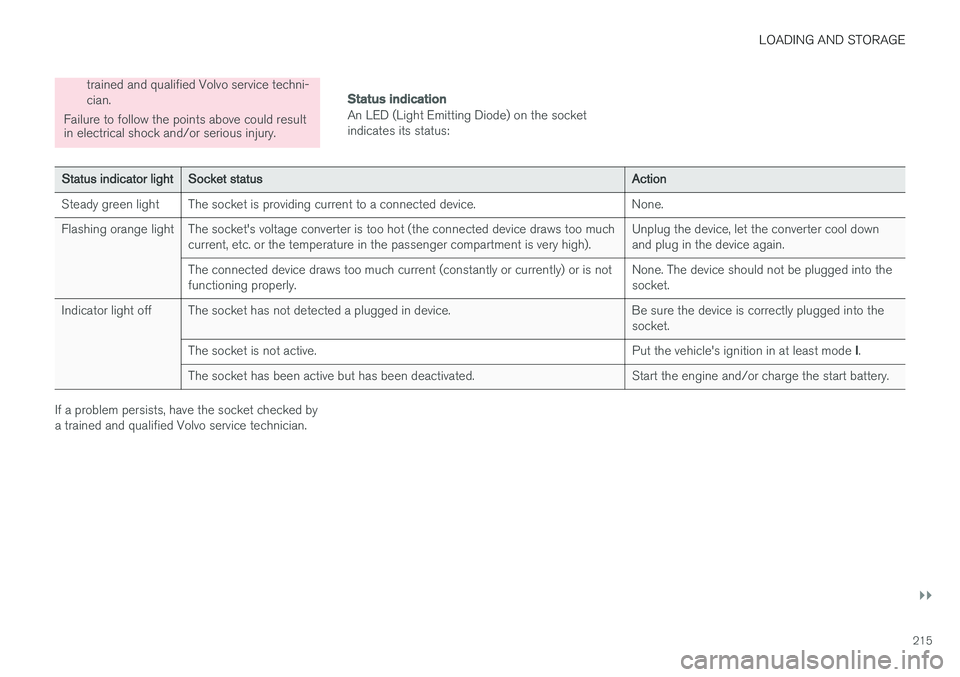
LOADING AND STORAGE
}}
215
trained and qualified Volvo service techni- cian.
Failure to follow the points above could result in electrical shock and/or serious injury.Status indication
An LED (Light Emitting Diode) on the socket indicates its status:
Status indicator light Socket status Action
Steady green light The socket is providing current to a connected device. None.
Flashing orange light The socket's voltage converter is too hot (the connected device draws too much current, etc. or the temperature in the passenger compartment is very high). Unplug the device, let the converter cool down and plug in the device again.
The connected device draws too much current (constantly or currently) or is notfunctioning properly. None. The device should not be plugged into thesocket.
Indicator light off The socket has not detected a plugged in device. Be sure the device is correctly plugged into the socket.
The socket is not active. Put the vehicle's ignition in at least mode I.
The socket has been active but has been deactivated. Start the engine and/or charge the start battery.
If a problem persists, have the socket checked by a trained and qualified Volvo service technician.
Page 218 of 552
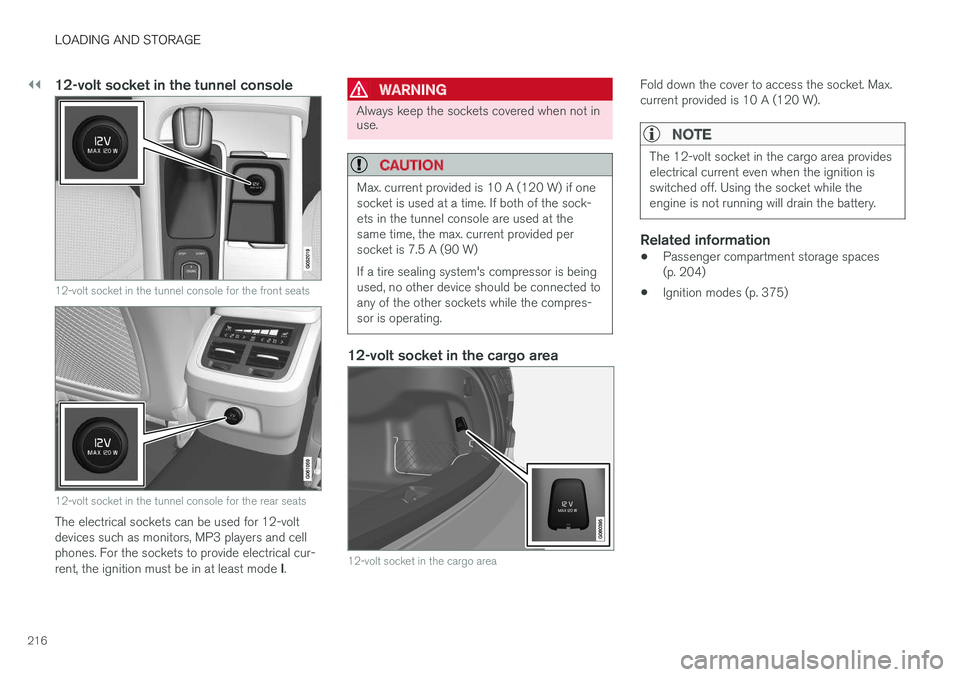
||
LOADING AND STORAGE
216
12-volt socket in the tunnel console
12-volt socket in the tunnel console for the front seats
12-volt socket in the tunnel console for the rear seats
The electrical sockets can be used for 12-volt devices such as monitors, MP3 players and cellphones. For the sockets to provide electrical cur- rent, the ignition must be in at least mode I.
WARNING
Always keep the sockets covered when not in use.
CAUTION
Max. current provided is 10 A (120 W) if one socket is used at a time. If both of the sock-ets in the tunnel console are used at thesame time, the max. current provided persocket is 7.5 A (90 W) If a tire sealing system's compressor is being used, no other device should be connected toany of the other sockets while the compres-sor is operating.
12-volt socket in the cargo area
12-volt socket in the cargo area
Fold down the cover to access the socket. Max. current provided is 10 A (120 W).
NOTE
The 12-volt socket in the cargo area provides electrical current even when the ignition isswitched off. Using the socket while theengine is not running will drain the battery.
Related information
• Passenger compartment storage spaces (p. 204)
• Ignition modes (p. 375)
Page 219 of 552
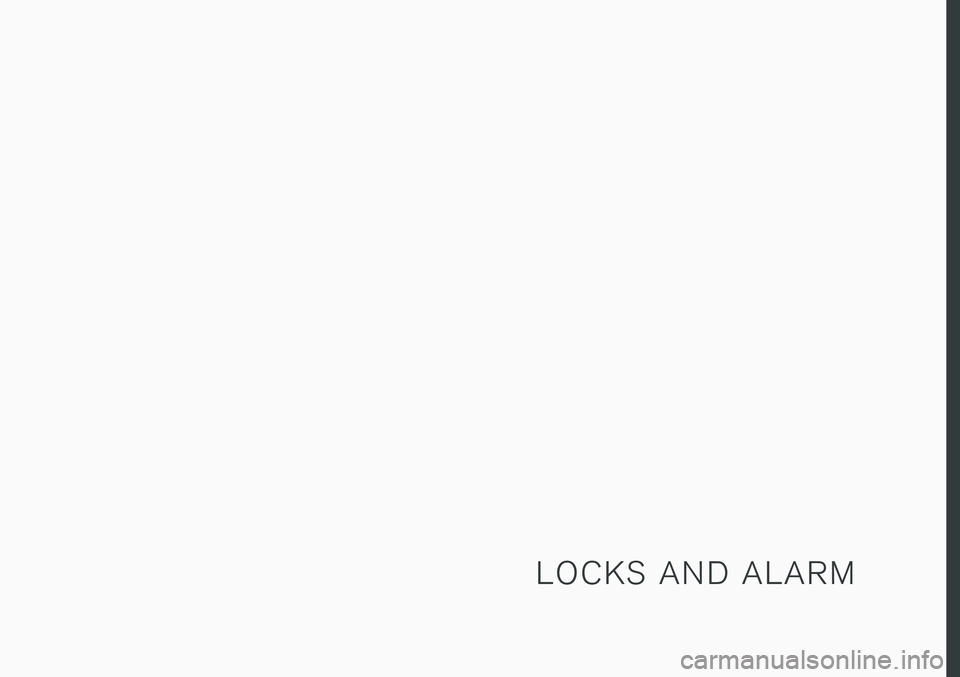
L O C K S A N D A L A R M
Page 220 of 552
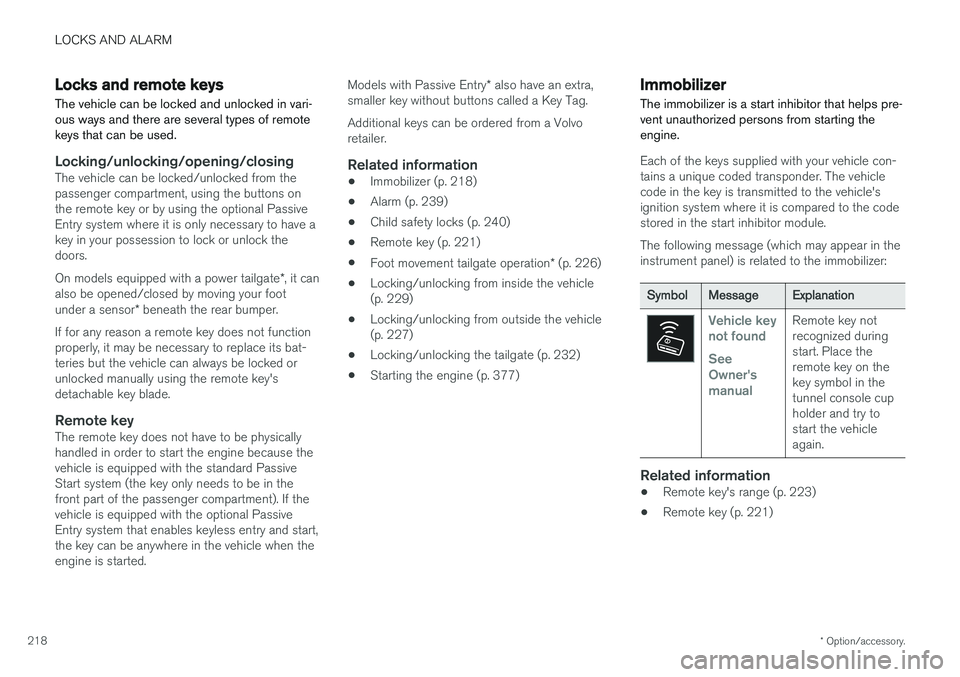
LOCKS AND ALARM
* Option/accessory.
218
Locks and remote keys
The vehicle can be locked and unlocked in vari- ous ways and there are several types of remotekeys that can be used.
Locking/unlocking/opening/closingThe vehicle can be locked/unlocked from the passenger compartment, using the buttons onthe remote key or by using the optional PassiveEntry system where it is only necessary to have akey in your possession to lock or unlock thedoors. On models equipped with a power tailgate *, it can
also be opened/closed by moving your foot under a sensor * beneath the rear bumper.
If for any reason a remote key does not function properly, it may be necessary to replace its bat-teries but the vehicle can always be locked orunlocked manually using the remote key'sdetachable key blade.
Remote keyThe remote key does not have to be physicallyhandled in order to start the engine because thevehicle is equipped with the standard PassiveStart system (the key only needs to be in thefront part of the passenger compartment). If thevehicle is equipped with the optional PassiveEntry system that enables keyless entry and start,the key can be anywhere in the vehicle when theengine is started. Models with Passive Entry
* also have an extra,
smaller key without buttons called a Key Tag. Additional keys can be ordered from a Volvo retailer.
Related information
• Immobilizer (p. 218)
• Alarm (p. 239)
• Child safety locks (p. 240)
• Remote key (p. 221)
• Foot movement tailgate operation
* (p. 226)
• Locking/unlocking from inside the vehicle(p. 229)
• Locking/unlocking from outside the vehicle(p. 227)
• Locking/unlocking the tailgate (p. 232)
• Starting the engine (p. 377)
Immobilizer
The immobilizer is a start inhibitor that helps pre- vent unauthorized persons from starting theengine.
Each of the keys supplied with your vehicle con- tains a unique coded transponder. The vehiclecode in the key is transmitted to the vehicle'signition system where it is compared to the codestored in the start inhibitor module. The following message (which may appear in the instrument panel) is related to the immobilizer:
Symbol Message Explanation
Vehicle key not found See Owner'smanualRemote key not recognized duringstart. Place theremote key on thekey symbol in thetunnel console cupholder and try tostart the vehicleagain.
Related information
•Remote key's range (p. 223)
• Remote key (p. 221)